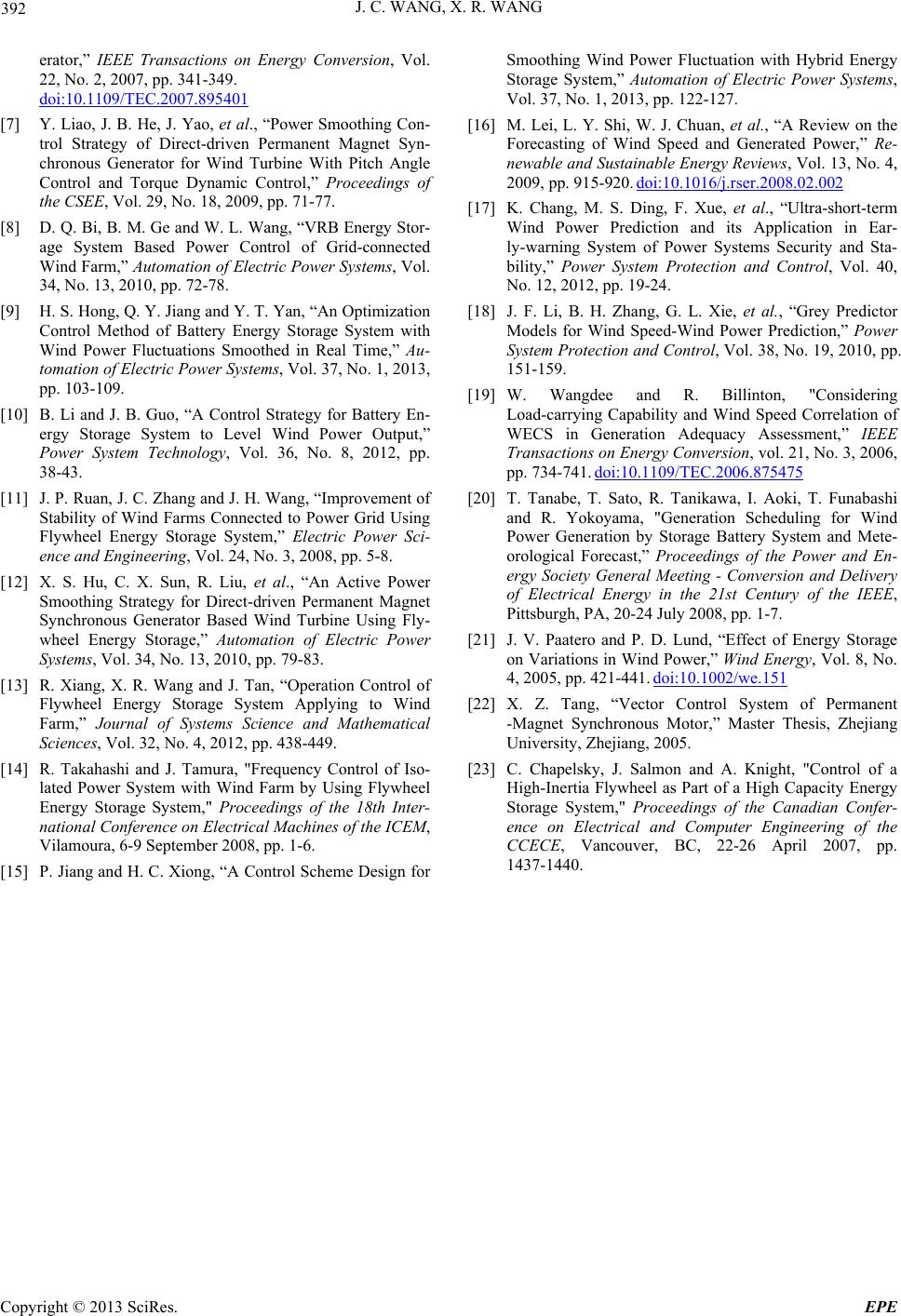
J. C. WANG, X. R. WANG
Copyright © 2013 SciRes. EPE
392
erator,” IEEE Transactions on Energy Conversion, Vol.
22, No. 2, 2007, pp. 341-349.
doi:10.1109/TEC.2007.895401
“Power Smoothing Con-
Energy Stor-
T. Yan, “An Optimization
. Guo, “A Control Strategy for Battery En-
an, J. C. Zhang and J. H. Wang, “Improvement of
wer
ion Control of
ntrol of
eme Design for
[7] Y. Liao, J. B. He, J. Yao, et al.,
trol Strategy of Direct-driven Permanent Magnet Syn-
chronous Generator for Wind Turbine With Pitch Angle
Control and Torque Dynamic Control,” Proceedings of
the CSEE, Vol. 29, No. 18, 2009, pp. 71-77.
[8] D. Q. Bi, B. M. Ge and W. L. Wang, “VRB
age System Based Power Control of Grid-connected
Wind Farm,” Automation of Electric Power Systems, Vol.
34, No. 13, 2010, pp. 72-78.
[9] H. S. Hong, Q. Y. Jiang and Y.
Control Method of Battery Energy Storage System with
Wind Power Fluctuations Smoothed in Real Time,” Au-
tomation of Electric Power Systems, Vol. 37, No. 1, 2013,
pp. 103-109.
[10] B. Li and J. B
ergy Storage System to Level Wind Power Output,”
Power System Technology, Vol. 36, No. 8, 2012, pp.
38-43.
[11] J. P. Ru
Stability of Wind Farms Connected to Power Grid Using
Flywheel Energy Storage System,” Electric Power Sci-
ence and Engineering, Vol. 24, No. 3, 2008, pp. 5-8.
[12] X. S. Hu, C. X. Sun, R. Liu, et al., “An Active Po
Smoothing Strategy for Direct-driven Permanent Magnet
Synchronous Generator Based Wind Turbine Using Fly-
wheel Energy Storage,” Automation of Electric Power
Systems, Vol. 34, No. 13, 2010, pp. 79-83.
[13] R. Xiang, X. R. Wang and J. Tan, “Operat
Flywheel Energy Storage System Applying to Wind
Farm,” Journal of Systems Science and Mathematical
Sciences, Vol. 32, No. 4, 2012, pp. 438-449.
[14] R. Takahashi and J. Tamura, "Frequency Co Iso-
lated Power System with Wind Farm by Using Flywheel
Energy Storage System," Proceedings of the 18th Inter-
national Conference on Electrical Machines of the ICEM,
Vilamoura, 6-9 September 2008, pp. 1-6.
[15] P. Jiang and H. C. Xiong, “A Control Sch
Smoothing Wind Power Fluctuation with Hybrid Energy
Storage System,” Automation of Electric Power Systems,
Vol. 37, No. 1, 2013, pp. 122-127.
[16] M. Lei, L. Y. Shi, W. J. Chuan, et al., “A Review on the
Forecasting of Wind Speed and Generated Power,” Re-
newable and Sustainable Energy Reviews, Vol. 13, No. 4,
2009, pp. 915-920. doi:10.1016/j.rser.2008.02.002
[17] K. Chang, M. S. Ding, F. Xue, et al., “Ultra-short-term
Wind Power Prediction and its Application in Ear-
ly-warning System of Power Systems Security and Sta-
bility,” Power System Protection and Control, Vol. 40,
No. 12, 2012, pp. 19-24.
[18] J. F. Li, B. H. Zhang, G. L. Xie, et al., “Grey Predictor
Models for Wind Speed-Wind Power Prediction,” Power
System Protection and Control, Vol. 38, No. 19, 2010, pp.
151-159.
[19] W. Wangdee and R. Billinton, "Considering
Load-carrying Capability and Wind Speed Correlation of
WECS in Generation Adequacy Assessment,” IEEE
Transactions on Energy Conversion, vol. 21, No. 3, 2006,
pp. 734-741. doi:10.1109/TEC.2006.875475
[20] T. Tanabe, T. Sato, R. Tanikawa, I. Aoki, T. Funabashi
and R. Yokoyama, "Generation Scheduling for Wind
Power Generation by Storage Battery System and Mete-
orological Forecast,” Proceedings of the Power and En-
ergy Society General Meeting - Conversion and Delivery
of Electrical Energy in the 21st Century of the IEEE,
Pittsburgh, PA, 20-24 July 2008, pp. 1-7.
[21] J. V. Paatero and P. D. Lund, “Effect of Energy Storage
on Variations in Wind Power,” Wind Energy, Vol. 8, No.
4, 2005, pp. 421-441. doi:10.1002/we.151
[22] X. Z. Tang, “Vector Control System of Permanent
-Magnet Synchronous Motor,” Master Thesis, Zhejiang
University, Zhejiang, 2005.
[23] C. Chapelsky, J. Salmon and A. Knight, "Control of a
High-Inertia Flywheel as Part of a High Capacity Energy
Storage System," Proceedings of the Canadian Confer-
ence on Electrical and Computer Engineering of the
CCECE, Vancouver, BC, 22-26 April 2007, pp.
1437-1440.